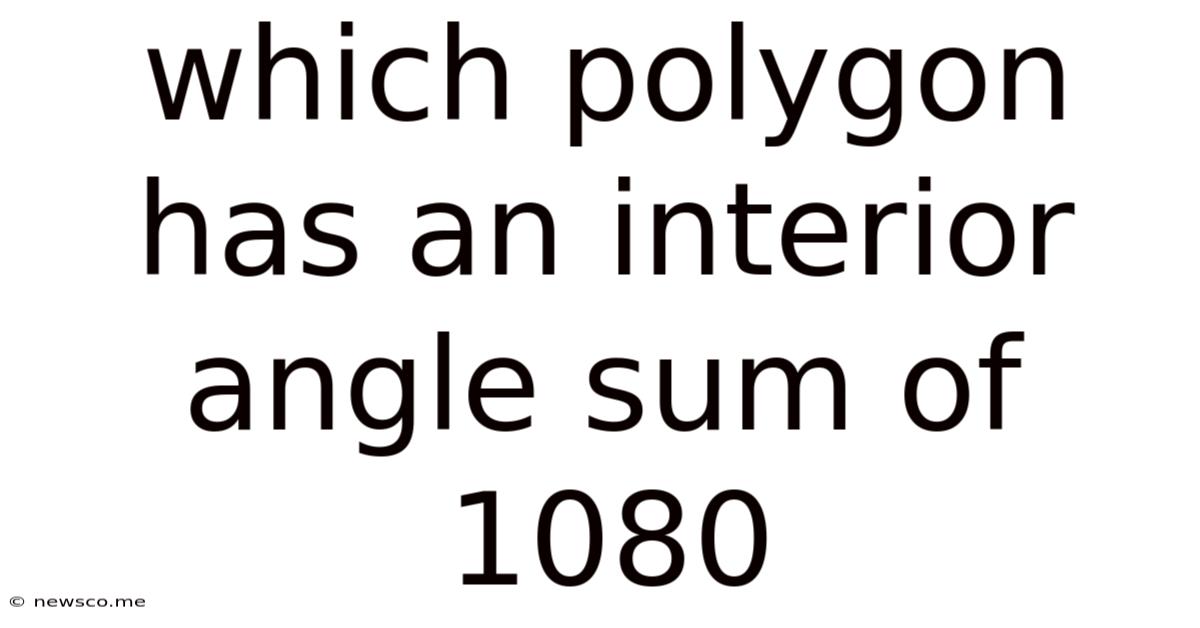Which Polygon Has An Interior Angle Sum Of 1080
News Co
Apr 17, 2025 · 4 min read

Table of Contents
Which Polygon Has an Interior Angle Sum of 1080?
Determining which polygon possesses an interior angle sum of 1080 degrees requires a solid understanding of polygon properties and a bit of mathematical maneuvering. This article will not only answer that question but also delve into the underlying principles, providing you with a comprehensive understanding of polygon angles and their calculations. We'll explore different methods for solving this type of problem, offering a range of approaches to suit various mathematical skill levels.
Understanding Polygon Interior Angles
Before diving into the specific problem, let's establish a foundational understanding of polygon interior angles. A polygon is a closed two-dimensional figure composed of straight line segments. These segments are called the sides of the polygon, and the points where the sides meet are called vertices. The interior angles are the angles formed inside the polygon at each vertex.
The sum of the interior angles of a polygon is directly related to the number of sides it has. This relationship is expressed in a simple formula:
(n - 2) * 180°
Where 'n' represents the number of sides of the polygon. This formula holds true for all convex polygons – those polygons where all interior angles are less than 180°.
Solving for 'n': Finding the Number of Sides
Our problem states that the interior angle sum is 1080°. We can use the formula above to determine the number of sides ('n') of the polygon:
(n - 2) * 180° = 1080°
Now we solve for 'n':
- Divide both sides by 180°: (n - 2) = 6
- Add 2 to both sides: n = 8
Therefore, a polygon with an interior angle sum of 1080° has 8 sides. This polygon is an octagon.
Different Approaches to the Problem
While the formula above provides a direct and efficient solution, let's explore alternative methods to solidify our understanding.
Method 2: Triangulation
This method involves dividing the polygon into triangles. Every polygon can be divided into triangles by drawing diagonals from a single vertex to all other non-adjacent vertices. The number of triangles formed is always two less than the number of sides (n-2). Since each triangle has an interior angle sum of 180°, the total interior angle sum of the polygon is (n-2) * 180°.
For our problem, we know the total interior angle sum is 1080°. Therefore:
(n - 2) * 180° = 1080°
Solving this equation, as shown previously, yields n = 8.
Method 3: Regular Polygons and Individual Angle Calculation
If the polygon is a regular polygon (meaning all sides and angles are equal), we can calculate the measure of each individual interior angle. The formula for the measure of each interior angle of a regular polygon is:
[(n - 2) * 180°] / n
Let's assume, for the moment, that our polygon with a 1080° interior angle sum is regular. We can set up the equation:
[(n - 2) * 180°] / n = 1080°/n (Since each angle would be 1080°/n in a regular octagon)
While this equation seems more complex, solving it will still lead us to n = 8. However, it is important to remember that this method only works if the polygon is regular.
Octagons: A Deeper Dive
Now that we've established that the polygon is an octagon, let's delve deeper into the properties of octagons.
Types of Octagons
Octagons are classified into different types based on their side lengths and angles:
- Regular Octagon: All sides are equal in length, and all interior angles are equal (135° each).
- Irregular Octagon: Sides and angles are of varying lengths and measures. The only requirement is that the sum of its interior angles remains 1080°.
Real-World Examples of Octagons
Octagons are found in various aspects of our world:
- Stop signs: The classic octagonal shape makes them easily recognizable.
- Architecture: Certain buildings incorporate octagonal designs.
- Crystals: Some crystals naturally form octagonal structures.
- Tessellations: Octagons can be used to create interesting geometric patterns.
Beyond Octagons: Expanding Our Knowledge
Understanding polygon interior angles goes beyond solving a single problem. It opens up a wider understanding of geometry and its applications. This knowledge is crucial in various fields, including:
- Architecture and Engineering: Calculating angles is vital for structural integrity and design.
- Computer Graphics and Game Development: Polygons are the building blocks of 3D models.
- Cartography: Understanding polygons helps in map creation and representation.
Conclusion: Mastering Polygon Angle Sums
Determining that an octagon possesses an interior angle sum of 1080° involves applying a fundamental geometric formula and understanding the relationship between the number of sides and the total interior angle sum. This article has explored several methods for arriving at this conclusion, reinforcing the importance of both understanding the underlying principles and employing efficient problem-solving techniques. By grasping these concepts, you can confidently tackle similar problems involving polygons of any size and shape, expanding your geometrical proficiency and problem-solving skills. Remember to explore different approaches to strengthen your understanding and appreciation of geometric principles. The more you practice, the more proficient you'll become.
Latest Posts
Related Post
Thank you for visiting our website which covers about Which Polygon Has An Interior Angle Sum Of 1080 . We hope the information provided has been useful to you. Feel free to contact us if you have any questions or need further assistance. See you next time and don't miss to bookmark.